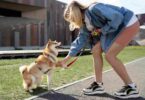Training a dog is not just about teaching basic commands like “sit” or “stay.” No, it’s about forging a deeper bond, creating a mutual understanding, and unlocking the full potential of your dog’s abilities. As you journey into the realm of advanced obedience training, the methods become more nuanced, the expectations higher, and the rewards—oh, they become exponentially more satisfying.
1. The Power of Positive Reinforcement
Positive reinforcement, the cornerstone of modern training, isn’t just about handing out treats. It’s about timing. It’s about consistency. And, most importantly, it’s about understanding the psychology of your dog. The next time your dog successfully follows a complex command, don’t just toss a treat; make it an experience. Reward them not just for the action, but for the effort. The joy, the excitement, the enthusiasm—this is what reinforces the behavior. With time, your dog will eagerly anticipate the rewards, not just the treats themselves, but the interaction, the connection, the shared moment of success.
2. Impulse Control: More Than Just Sit and Stay
Ah, impulse control. If only it were as easy as telling your dog to “stay.” But real impulse control, the kind that allows your dog to focus under pressure, requires a finely tuned balance of patience and precision. The exercises, such as “leave it” or “wait,” demand more than just compliance—they demand an internal shift within the dog. They must learn to pause their instincts, assess the situation, and wait for permission before acting. But here’s where it gets interesting—it’s not only about stopping the dog from doing something. It’s about teaching them to choose to refrain from acting. This shift from passive obedience to conscious choice is the essence of advanced impulse control.
3. The Magic of Multi-Tasking: Proofing Your Dog’s Skills
What happens when your dog masters “sit” and “stay” at home but becomes a bundle of chaos the moment you step into a distracting environment? This is where proofing comes into play. Proofing is the art of ensuring that your dog can perform commands not just in the comfort of your living room, but in the face of distractions, on a walk, at the park, or around other animals. It’s about making sure that your dog is not only responding to commands but also learning to generalize the behavior to any and every scenario. Picture it: a dog who can remain calm and seated despite the fluttering of leaves, the hustle of traffic, or the presence of other dogs. The achievement of proofing is nothing short of magic—transforming basic commands into reliable, go-anywhere skills.
4. Mental Stimulation and Problem Solving: Elevating the Game
At this stage, it’s no longer about just following commands; it’s about engaging the mind. Advanced obedience training invites dogs into a world of mental stimulation, where complex problems are solved, and cognitive abilities are tested. Introducing activities such as puzzle-solving tasks, scent work, or even agility drills that require quick thinking and adaptability pushes your dog’s brain to its limits. The beauty of this level of training lies in its unpredictability. No two sessions are the same. A game that challenges the dog’s intelligence today might be different tomorrow, evolving based on your dog’s learning curve.
5. The Importance of Timing and Consistency
Consistency might sound like a given, but in advanced obedience training, it becomes an art form. You must be there, ready to reward the behavior at exactly the right moment. A half-second too early or too late, and you risk sending the wrong message. Timing affects the learning process more than most realize. Without it, even the most complex tasks fall apart. The slightest change in approach can determine whether your dog succeeds or falters. It’s about mastering the rhythm of your relationship with your dog. And this is where the human element comes into play. It’s about understanding, adjusting, and reacting, all while maintaining that balance between firmness and compassion.
6. Building a Stronger Bond
Advanced obedience training isn’t just about the dog following commands; it’s about you and your dog becoming a team. Every command is an opportunity to build trust. Every challenge is a chance to communicate on a deeper level. As you both master increasingly sophisticated techniques, you’ll notice the shift: the dog who once viewed you as simply an authority figure becomes a partner in the dance of communication. You are no longer just the trainer. You are a teammate. And this bond, forged through mutual respect and consistent effort, is the ultimate reward.
7. Continuous Learning: The Journey Never Ends
Training a dog isn’t a destination; it’s a lifelong journey. Even as your dog masters new commands and behaviors, there is always room for growth, for new challenges, and for new opportunities to strengthen the bond between you. The moment you think you’ve reached the pinnacle of advanced obedience is the moment the next challenge reveals itself.
This ever-evolving journey is one that demands patience, persistence, and passion. So, keep your mind open, your training sessions diverse, and your connection with your dog unbreakable. The world of advanced obedience training is vast, and the possibilities are endless.



